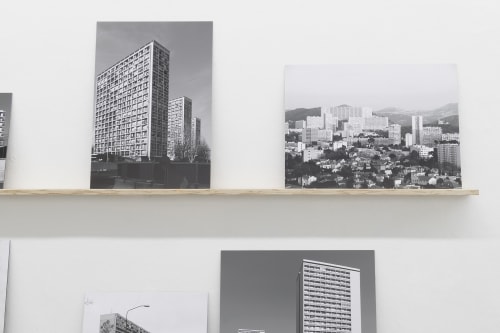In the Run-up to Spain’s Tense National Elections, Excavating the State-Designed Oppression Inherited from the Franco Years
Domènec’s show at adn galeria, Barcelona looks to the fraught legacies of Spain’s mass communal housing
Taking its title from the Spanish lyrics of the socialist workers’ anthem ‘L’Internationale’ (1871), ‘Y la tierra será el paraíso’ (And Earth Will Be Paradise) is the first solo show by Domènec at adn galería. The show follows his retrospective at the Museu d’Art Contemporani de Barcelona last year. Since the late 1990s, Domènec’s art has addressed the intersection of modern architecture and social disenfranchisement, the friction between utopian urbanism and the lived experience of the people who have often borne its most deleterious effects: workers, immigrants and the economically disadvantaged.
‘Sostenere il palazzo dell’utopia’ (Sustaining the Palace of Utopia, 2004) is a series of ten portraits of residents in and around Corviale, a housing development on the outskirts of Rome, the construction of which began in 1972 and which became unofficially occupied following the constructor’s bankruptcy a decade later. Almost one kilometre in length, Corviale scaled up the modernist dream of mass communal housing with dysfunctional results. Yet, Domènec’s photographs resist the brutality of this architectural dysmorphia; instead, they depict neighbours on a domestic scale. Posing with a maquette of Le Corbusier’s Cité radieuse in Marseille, the occupants of Corviale are, by contrast, the self-appointed developers of their own urban vision. Their portraits face-off against six rows of monochrome images on the opposite wall, which include representations of hive-like mass housing in the architectural press, publicity shots of Le Corbusier admiring building models, as well as this latter imagery’s echo in medieval Spanish painting, where religious patrons are depicted holding miniature cathedrals. A series of white-on-black architectural and topological plans with accompanying captions, ‘Arquitectura Española, 1939–1975’ (2014–18), further examines the instrumentalization of large-scale construction projects as tools of sociopolitical oppression, here in the context of the especially malignant mix of state modernism and religious omnipotence meted out in Spain during the years of Francisco Franco’s dictatorship. Each of the structures or urban areas represented in the series, ten of which are included here, were built or reconstructed through the labour of Republican prisoners. The vanquished were punished and humiliated by being forced to construct the infrastructure of the very fascist state they had resisted.
Many of the places that Domènec holds up for scrutiny in these X-ray-like panels still poison Spain’s contemporary consciousness, most notoriously the Valle de los Caídos: a mausoleum and mass grave that the current Socialist government is attempting to detoxify through fraught moves to exhume Franco’s body from the site. Yet, as Spain now witnesses a zombie-like reanimation of an extreme Right that refuses to be buried, in the form of the Vox party, Domènec urges critical vigilance not just of conspicuous monuments but of any public discourse of renewal – especially at the margins of what theorist Keller Easterling calls infrastructure space.
Accordingly, the artist’s new project, Y la tierra será el paraíso (2019), addresses the troubled La Mina neighbourhood on the edge of Barcelona, whose 1970s tower blocks were originally built to house an influx of mainly Andalusian and Romani people from nearby shanty towns. Made up of a stack of 14 desk-sized wooden maquettes, the sculpture ironically upgrades the decaying housing units into something resembling a game of Jenga and evokes. The Interlace, the upmarket 1,000-unit apartment complex in Singapore designed by OMA and Ole Scheeren (completed in 2013). To one side of the sculpture is an archival photograph of Franco approving La Mina’s masterplan in 1970. On the other, an undated newspaper clipping, printed on a socialist red background, shows three La Mina women proudly displaying cardboard models of their shanty homes which were cleared for the monolithic development. Countering the potential of the architectural model as a modern tool for projecting mastery and sanctioning duplication, it is these women’s humble shack maquettes, as if ever-ready to be scaled-up into lifesized memories, that Domènec ensures will have the last word.
Domènec, 'Y la tierra será el paraíso' runs at adn galería, Barcelona, until 16 March 2019.


